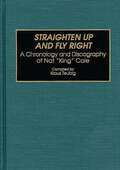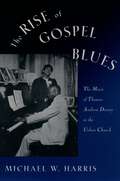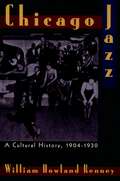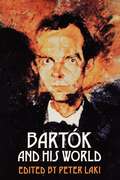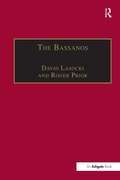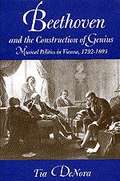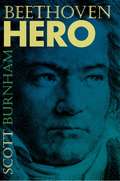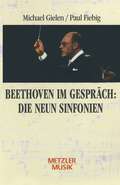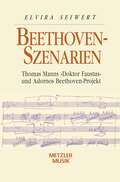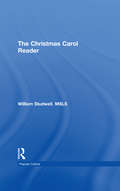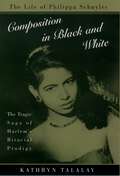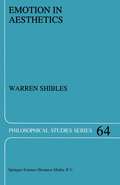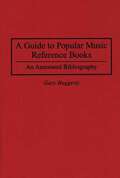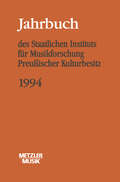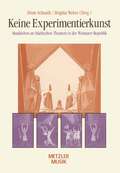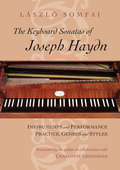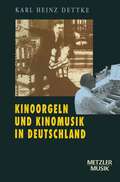- Table View
- List View
Straighten Up and Fly Right: A Chronology and Discography of Nat King Cole (Discographies: Association for Recorded Sound Collections Discographic Reference)
by Klaus TeubigThirty years of collecting and 15 years of research have resulted in this discography that features all known recordings, transcriptions, and films made by Cole until 1950, when his jazz style faded away, and a selection of his later jazz-related trio sides. It includes for the first time Cole's unknown 16 transcriptions of his Wild Root broadcasts. This volume documents the development of a gifted pianist into a ballad-singing star and leader of the most famous jazz trio of the 1940s. All routes and recording activities by Cole and his fellow musicians from 1936 to the 1950s are chronicled here.Nat King Cole is widely known as a singer of unforgettable fame, but that he was a true King of Jazz Piano in its heyday and the inventor of today's piano trios is almost forgotten. This discography gives all details of the King Cole Trio's activities, listing recording sessions, available broadcasts on discs, film soundtracks, and guest appearances by the trio or by Cole alone, on such shows as Jubilee, Command Performance, Supper Club, Mail Call, and Kraft Music Hall. A special listing is included of those occasions when Cole participated as unknown or unnamed pianist on radio transcriptions for singers like Anita Boyer, Anita O'Day, The Dreamers, The Barrie Sisters, Bonnie Lake, Rose Murphy, Maxine Johnson, and Juanelda Carter. In addition, the book includes the Cole Trio's engagement routes with exact dates if known, names of promoters, and much more. The biographical portion is a fascinating period piece of Jazz-age memorabilia.
The Rise of Gospel Blues: The Music of Thomas Andrew Dorsey in the Urban Church
by Michael W. HarrisMost observers believe that gospel music has been sung in African-American churches since their organization in the late 1800s. Yet nothing could be further from the truth, as Michael W. Harris's history of gospel blues reveals. Tracing the rise of gospel blues as seen through the career of its founding figure, Thomas Andrew Dorsey, Harris tells the story of the most prominent person in the advent of gospel blues. Also known as "Georgia Tom," Dorsey had considerable success in the 1920s as a pianist, composer, and arranger for prominent blues singes including Ma Rainey. In the 1930s he became involved in Chicago's African-American, old-line Protestant churches, where his background in the blues greatly influenced his composing and singing. Following much controversy during the 1930s and the eventual overwhelming response that Dorsey's new form of music received, the gospel blues became a major force in African-American churches and religion. His more than 400 gospel songs and recent Grammy Award indicate that he is still today the most prolific composer/publisher in the movement. Delving into the life of the central figure of gospel blues, Harris illuminates not only the evolution of this popular musical form, but also the thought and social forces that forged the culture in which this music was shaped.
Chicago Jazz: A Cultural History, 1904-1930
by William Howland KenneyThe setting is the Royal Gardens Cafe. It's dark, smoky. The smell of gin permeates the room. People are leaning over the balcony, their drinks spilling on the customers below. On stage, King Oliver and Louis Armstrong roll on and on, piling up choruses, the rhythm section building the beat until tables, chairs, walls, people, move with the rhythm. The time is the 1920s. The place is South Side Chicago, a town of dance halls and cabarets, Prohibition and segregation, a town where jazz would flourish into the musical statement of an era. In Chicago Jazz, William Howland Kenney offers a wide-ranging look at jazz in the Windy City, revealing how Chicago became the major center of jazz in the 1920s, one of the most vital periods in the history of the music. He describes how the migration of blacks from the South to Chicago during and after World War I set the stage for the development of jazz in Chicago; and how the nightclubs and cabarets catering to both black and white customers provided the social setting for jazz performances. Kenney discusses the arrival of King Oliver and other greats in Chicago in the late teens and the early 1920s, especially Louis Armstrong, who would become the most influential jazz player of the period. And he travels beyond South Side Chicago to look at the evolution of white jazz, focusing on the influence of the South Side school on such young white players as Mezz Mezzrow (who adopted the mannerisms of black show business performers, an urbanized southern black accent, and black slang); and Max Kaminsky, deeply influenced by Armstrong's "electrifying tone, his superb technique, his power and ease, his hotness and intensity, his complete mastery of the horn." The personal recollections of many others--including Milt Hinton, Wild Bill Davison, Bud Freeman, and Jimmy McPartland--bring alive this exciting period in jazz history. Here is a new interpretation of Chicago jazz that reveals the role of race, culture, and politics in the development of this daring musical style. From black-and-tan cabarets and the Savoy Ballroom, to the Friars Inn and Austin High, Chicago Jazz brings to life the hustle and bustle of the sounds and styles of musical entertainment in the famous toddlin' town.
Bad Seed: The Biography of Nick Cave
by Ian JohnstonA widely acclaimed biography of one of rock's most compelling, uncompromising and influential singer-songwriters, Ian Johnston's BAD SEED offers a superb overview of Nick Cave's career to date. Through Cave's fronting of the incendiary bands The Birthday Party and The Bad Seeds, producing music of unfettered expression and explosive intensity, to his creative collaborations outside of the rock industry in film and literature, BAD SEED illustrates a life lived in barely controlled chaos: and unravels the motivation and unique appeal of a reluctant icon whose songs, according to the Rolling Stones, possess "the authority of the most primal kind of myth."
Bartók and His World (PDF)
by Peter LakiBéla Bartók, who died in New York fifty years ago this September, is one of the most frequently performed twentieth-century composers. He is also the subject of a rapidly growing critical and analytical literature. Bartók was born in Hungary and made his home there for all but his last five years, when he resided in the United States. As a result, many aspects of his life and work have been accessible only to readers of Hungarian. The main goal of this volume is to provide English-speaking audiences with new insights into the life and reception of this musician, especially in Hungary. Part I begins with an essay by Leon Botstein that places Bartók in a large historical and cultural context. László Somfai reports on the catalog of Bartók's works that is currently in progress. Peter Laki shows the extremes of the composer's reception in Hungary, while Tibor Tallián surveys the often mixed reviews from the American years. The essays of Carl Leafstedt and Vera Lampert deal with his librettists Béla Balázs and Melchior Lengyel respectively. David Schneider addresses the artistic relationship between Bartók and Stravinsky. Most of the letters and interviews in Part II concern Bartók's travels and emigration as they reflected on his personal life and artistic evolution. Part III presents early critical assessments of Bartók's work as well as literary and poetic responses to his music and personality.
The Bassanos: Venetian Musicians and Instrument Makers in England, 1531-1665
by Roger PriorIn the 1530s, five Bassano brothers, who were outstanding wind players and instrument makers, emigrated from Venice to England. Dr Lasocki‘s authoritative new book, the first to be devoted to the family, is a minutely researched account of these brothers, their sons (and a daughter) and their grandsons. The first half of the book discusses the everyday affairs of the family - their relationships, religion, property, law suits, finances, and standing in society. Two chapters, one written by Roger Prior, are devoted to Emilia Bassano, whose identification as thedark lady of Shakespeare‘s sonnets is supported by a wealth of evidence. The second half of the book discusses the family‘s musical activities. At the English Court the Bassanos made up a recorder consort that lasted 90 years; they also played in the flute/cornett and shawm/sackbutt consorts. As instrument makers their fame was spread throughout Europe. The book‘s appendixes present information on the Venetian branch of the family and the musical activities of the English branch since 1665.
The Bassanos: Venetian Musicians and Instrument Makers in England, 1531-1665
by Roger PriorIn the 1530s, five Bassano brothers, who were outstanding wind players and instrument makers, emigrated from Venice to England. Dr Lasocki‘s authoritative new book, the first to be devoted to the family, is a minutely researched account of these brothers, their sons (and a daughter) and their grandsons. The first half of the book discusses the everyday affairs of the family - their relationships, religion, property, law suits, finances, and standing in society. Two chapters, one written by Roger Prior, are devoted to Emilia Bassano, whose identification as thedark lady of Shakespeare‘s sonnets is supported by a wealth of evidence. The second half of the book discusses the family‘s musical activities. At the English Court the Bassanos made up a recorder consort that lasted 90 years; they also played in the flute/cornett and shawm/sackbutt consorts. As instrument makers their fame was spread throughout Europe. The book‘s appendixes present information on the Venetian branch of the family and the musical activities of the English branch since 1665.
Beethoven And The Construction Of Genius: Musical Politics In Vienna, 1792-1803 (PDF)
by Tia DeNoraIn this provocative account Tia DeNora reconceptualizes the notion of genius by placing the life and career of Ludwig van Beethoven in its social context. She explores the changing musical world of late eighteenth-century Vienna and follows the activities of the small circle of aristocratic patrons who paved the way for the composer's success. DeNora reconstructs the development of Beethoven's reputation as she recreates Vienna's robust musical scene through contemporary accounts, letters, magazines, and myths-a colorful picture of changing times. She explores the ways Beethoven was seen by his contemporaries and the image crafted by his supporters. Comparing Beethoven to contemporary rivals now largely forgotten, DeNora reveals a figure musically innovative and complex, as well as a keen self-promoter who adroitly managed his own celebrity. DeNora contends that the recognition Beethoven received was as much a social achievement as it was the result of his personal gifts. In contemplating the political and social implications of culture, DeNora casts many aspects of Beethoven's biography in a new and different light, enriching our understanding of his success as a performer and composer.
Beethoven Hero
by Scott BurnhamBringing together reception history, music analysis and criticism, the history of music theory, and the philosophy of music, Beethoven Hero explores the nature and persistence of Beethoven's heroic style. What have we come to value in this music, asks Scott Burnham, and why do generations of critics and analysts hear it in much the same way? Specifically, what is it that fosters the intensity of listener engagement with the heroic style, the often overwhelming sense of identification with its musical process? Starting with the story of heroic quest heard time and again in the first movement of the Eroica Symphony, Burnham suggests that Beethoven's music matters profoundly to its listeners because it projects an empowering sense of self, destiny, and freedom, while modeling ironic self-consciousness. In addition to thus identifying Beethoven's music as an overarching expression of values central to the age of Goethe and Hegel, the author describes and then critiques the process by which the musical values of the heroic style quickly became the controlling model of compositional logic in Western music criticism and analysis. Apart from its importance for students of Beethoven, this book will appeal to those interested in canon formation in the arts and in music as a cultural, ethical, and emotional force--and to anyone concerned with what we want from music and what music does for us.
Beethoven-Szenarien: Thomas Manns "Doktor Faustus" und Adornos Beethoven-Projekt
by Elvira SeiwertElvira Seiwert lotet die Beethoven-Bezüge von Thomas Manns "Doktor Faustus" aus und stellt sie in den Zusammenhang von Adornos musikphilologischen Beethoven-Projekt.
The Christmas Carol Reader
by William E Studwell Frank Hoffmann B Lee CooperLike that Biblical, astronomical star of Bethlehem, The Christmas Carol Reader guides readers on their quest for information about Christmas songs. Studwell gathers a composite picture of the world's most important and famous carols and includes an ample selection of lesser-known Christmas songs. All of the carols are presented in their historical and cultural contexts which adds to readers’understanding and appreciation of the songs.As the only book that covers this elusive topic, The Christmas Carol Reader informs and entertains readers on over 200 songs of all types (sacred and secular), of all periods (Middle Ages through the 20th century), and from a number of countries and cultures. Because many of the songs in The Christmas Carol Reader fit into more than one distinct category, Studwell wisely divides the songs into two major groups--those that reflect Christmas as a Holy Day and those that celebrate Christmas as a Holiday. Here is just a sample of the breadth of coverage of songs:Sacred: From Heaven Above to Earth I Come; O Come, O Come Emmanuel; Angels From the Realms of Glory; As With Gladness Men of Old; O Holy Night (Cantique de Noël); Thou Didst Leave Thy ThroneSecular: Happy Holiday; A Holly Jolly Christmas; God Rest You Merry, Gentlemen; Silver Bells; Here Comes Santa Claus; I'll Be Home for ChristmasMedieval: Puer Natus in Bethlehem (A Boy Is Born in Bethlehem); Coventry Carol; I Sing of a Maiden; La marche des rois (The March of the Kings); In Dulci Jubilo1500--1700's: Bring a Torch, Jeanette, Isabella; I Saw Three Ships; Carol of the Bagpipers1800's: Adeste Fideles (O Come All Ye Faithful); O Little Town of Bethlehem; What Child Is This?; It Came Upon a Midnight Clear; Stille Nacht, Heiliege Nacht (Silent Night)Spirituals: Go Tell It on the Mountain; I Wonder as I Wander; Mary Had a Baby; Rise Up, Shepherd, and FollowLittle Known: O Bethlehem!; The Sleep of the Infant Jesus; Song of the Nuns of ChesterCountries and Cultures: O Tannenbaum; Lulajze Jezuniu (Polish Lullaby); Fum, Fum, Fum; Carol of the Bells; Patapan; El rorro (The Babe)As readers learn about the history and nature of the Christmas carol in general and the specific history of individual religious and secular carols, they will learn some history and nature of the holiday season which can bring more enjoyment into their celebrations for years to come.On long winter nights, The Christmas Carol Reader can be read continuously as a series of fact-based commentaries on Christmas music. For shorter periods in between holiday activities, readers can peruse one of the topical sections or select, with the aid of the title index, an individual essay of interest. As a library reference, this book can provide facts for research on Christmas songs or just provide an entertaining education for curious library patrons.
The Christmas Carol Reader
by William E Studwell Frank Hoffmann B Lee CooperLike that Biblical, astronomical star of Bethlehem, The Christmas Carol Reader guides readers on their quest for information about Christmas songs. Studwell gathers a composite picture of the world's most important and famous carols and includes an ample selection of lesser-known Christmas songs. All of the carols are presented in their historical and cultural contexts which adds to readers’understanding and appreciation of the songs.As the only book that covers this elusive topic, The Christmas Carol Reader informs and entertains readers on over 200 songs of all types (sacred and secular), of all periods (Middle Ages through the 20th century), and from a number of countries and cultures. Because many of the songs in The Christmas Carol Reader fit into more than one distinct category, Studwell wisely divides the songs into two major groups--those that reflect Christmas as a Holy Day and those that celebrate Christmas as a Holiday. Here is just a sample of the breadth of coverage of songs:Sacred: From Heaven Above to Earth I Come; O Come, O Come Emmanuel; Angels From the Realms of Glory; As With Gladness Men of Old; O Holy Night (Cantique de Noël); Thou Didst Leave Thy ThroneSecular: Happy Holiday; A Holly Jolly Christmas; God Rest You Merry, Gentlemen; Silver Bells; Here Comes Santa Claus; I'll Be Home for ChristmasMedieval: Puer Natus in Bethlehem (A Boy Is Born in Bethlehem); Coventry Carol; I Sing of a Maiden; La marche des rois (The March of the Kings); In Dulci Jubilo1500--1700's: Bring a Torch, Jeanette, Isabella; I Saw Three Ships; Carol of the Bagpipers1800's: Adeste Fideles (O Come All Ye Faithful); O Little Town of Bethlehem; What Child Is This?; It Came Upon a Midnight Clear; Stille Nacht, Heiliege Nacht (Silent Night)Spirituals: Go Tell It on the Mountain; I Wonder as I Wander; Mary Had a Baby; Rise Up, Shepherd, and FollowLittle Known: O Bethlehem!; The Sleep of the Infant Jesus; Song of the Nuns of ChesterCountries and Cultures: O Tannenbaum; Lulajze Jezuniu (Polish Lullaby); Fum, Fum, Fum; Carol of the Bells; Patapan; El rorro (The Babe)As readers learn about the history and nature of the Christmas carol in general and the specific history of individual religious and secular carols, they will learn some history and nature of the holiday season which can bring more enjoyment into their celebrations for years to come.On long winter nights, The Christmas Carol Reader can be read continuously as a series of fact-based commentaries on Christmas music. For shorter periods in between holiday activities, readers can peruse one of the topical sections or select, with the aid of the title index, an individual essay of interest. As a library reference, this book can provide facts for research on Christmas songs or just provide an entertaining education for curious library patrons.
Composition in Black and White: The Life of Philippa Schuyler
by Kathryn TalalayGeorge Schuyler, a renowned and controversial black journalist of the Harlem Renaissance, and Josephine Cogdell, a blond, blue-eyed Texas heiress and granddaughter of slave owners, believed that intermarriage would "invigorate" the races, thereby producing extraordinary offspring. Their daughter, Philippa Duke Schuyler, became the embodiment of this theory, and they hoped she would prove that interracial children represented the final solution to America's race problems. Able to read and write at the age of two and a half, a pianist at four, and a composer by five, Philippa was often compared to Mozart. During the 1930s and 40s she graced the pages of Time and Look magazines, the New York Herald Tribune, and The New Yorker. Philippa grew up under the adoring and inquisitive eyes of an entire nation and soon became the role model and inspiration for a generation of African-American children. But as an adult she mysteriously dropped out of sight, leaving America to wonder what had happened to the "little Harlem genius." Suffering the double sting of racism and gender bias, Philippa had been rejected by the elite classical music milieu in the United States and forced to find an audience abroad, where she flourished as a world-class performer and composer. She traveled throughout South America, Europe, Africa, and Asia performing for kings, queens, and presidents. By then Philippa had added a second career as an author and foreign correspondent reporting on events around the globe--from Albert Schweitzer's leper colony in Lamberéné to the turbulent Asian theater of the 1960s. She would give a command performance for Queen Elisabeth of Belgium one day, and hide from the Viet Cong among the ancient graves of the Annam kings another. But behind the scrim of adventure, glamour, and intrigue was an American outcast, a woman constantly searching for home and self. "I am a beauty--but I'm half colored...so I'm always destined to be an outsider," she wrote in her diary. Philippa tried to define herself through love affairs, but found only disappointment and scandal. In a last attempt to reclaim an identity, she began to "pass" as Caucasian. Adopting an Iberian-American heritage, she reinvented herself as Felipa Monterro, an ultra-right conservative who wrote and lectured for the John Birch Society. Her experiment failed, as had her parents' dream of smashing America's racial barriers. But at the age of thirty five, Philippa finally began to embark on a racial catharsis: She was just beginning to find herself when on May 9, 1967, while on an unauthorized mission of mercy, her life was cut short in a helicopter crash over the waters of war-torn Vietnam. The first authorized biography of Philippa Schuyler, Composition in Black and White draws on previously unpublished letters and diaries to reveal an extraordinary and complex personality. Extensive research and personal interviews from around the world make this book not only the definitive chronicle of Schuyler's restless and haunting life, but also a vivid history of the tumultuous times she lived through, from the Great Depression, through the Civil Rights movement, to the Vietnam war. Talalay has created a highly perceptive and provocative portrait of a fascinating woman.
Emotion in Aesthetics (Philosophical Studies Series #64)
by Warren A. ShiblesEmotion in Aesthetics is the first book on aesthetics to provide an extensive theory of emotion; application of the cognitive-emotive theory to aesthetics; analysis of the relationship between aesthetics, metaphor and emotion; a full theory of meaning and its application to aesthetics; discussion of the relationship between aesthetics, music and language in terms of phonetics, phonology and intonation; an analysis of humanistic aesthetics; a well-developed naturalistic theory of ethics as applied to aesthetics and emotion. Stress is placed on the views of contemporary philosophers as well as some of the main historical accounts of emotion in aesthetics. The important recent work on emotion has not hitherto been applied to aesthetics. As a result there is still much confusion in aesthetics about aesthetic emotion and related concepts, such as the expression theory of emotion. The present book has been written to show how the theory can be used to clarify the issue, resulting in a major breakthrough in aesthetics. In addition, the theory presented is valuable in relating aesthetics to ethics and humanism.
Gamelan: Cultural Interaction and Musical Development in Central Java (Chicago Studies in Ethnomusicology #Volume 3)
by SumarsamGamelan is the first study of the music of Java and the development of the gamelan to take into account extensive historical sources and contemporary cultural theory and criticism. An ensemble dominated by bronze percussion instruments that dates back to the twelfth century in Java, the gamelan as a musical organization and a genre of performance reflects a cultural heritage that is the product of centuries of interaction between Hindu, Islamic, European, Chinese, and Malay cultural forces. Drawing on sources ranging from a twelfth-century royal poem to the writing of a twentieth-century nationalist, Sumarsam shows how the Indian-inspired contexts and ideology of the Javanese performing arts were first adjusted to the Sufi tradition and later shaped by European performance styles in the eighteenth and nineteenth centuries. He then turns to accounts of gamelan theory and practice from the colonial and postcolonial periods. Finally, he presents his own theory of gamelan, stressing the relationship between purely vocal melodies and classical gamelan composition.
A Guide to Popular Music Reference Books: An Annotated Bibliography (Music Reference Collection)
by Gary HaggertyA guide to locating information on popular music and the people who create it, this volume is designed as a desk reference—to locate answers to specific questions and to direct library users to key resources. More than 400 comprehensive titles are carefully annotated, describing content, scope, and special features. The focus is on the musical styles that have developed measurable commercial success through recordings and live performance. Along with academic titles, many important titles from the popular press are included, as well as selected electronic resources. A necessary reference tool for any library, scholar, student, and popular music buff.The work covers bibliographies, indexes, discographies, dictionaries and encyclopedias, biographical resources, directories, almanacs, yearbooks, and guidebooks on styles that include jazz, swing, Tin Pan Alley, country, gospel, blues, rhythm and blues, soul, rockabilly, rock, heavy metal, musical theater, and film music. Its extensive appendices feature discographies and bibliographies of individual artists and ensembles. A detailed index combining authors, titles, and subjects makes cross-referencing easy. The entries are modeled after the immensely useful The Guide to Reference Books.
Janelle Monáe’s The ArchAndroid (33 1/3)
by Alyssa FavreauIn Janelle Monáe's full-length debut, the science fiction concept album The ArchAndroid, the android Cindi Mayweather is on the run from the authorities for the crime of loving a human. Living in 28th century Metropolis, Cindi fights for survival, soon realizing that she is in fact the prophesied ArchAndroid, a robot messiah meant to liberate the masses and lead them toward a wonderland where all can be free.Taking into account the literary merit of Monáe's astounding multimedia body of work, the political relevance of the science fictional themes and aesthetics she explores, and her role as an Atlanta-based pop cultural juggernaut, this book explores the lavish world building of Cindi's story, and the many literary, cinematic, and musical influences brought together to create it. Throughout, a history of Monáe's move to Atlanta, her signing with Bad Boy Records, and the trials of developing a full-length concept album in an industry devoted to the production of marketable singles can be found, charting the artist's own rise to power. The stories of Monáe and of Cindi are inextricably entwined, each making the other more compelling, fantastical, and deeply felt.
The Keyboard Sonatas of Joseph Haydn: Instruments and Performance Practice, Genres and Styles
by László SomfaiInterest in the authentic performance of early music has grown dramatically in recent years, and scholarly investigation has particularly benefited the study of keyboard music of the classical period. In this landmark publication, the most comprehensive study written on Haydn's keyboard sonatas, a leading Haydn scholar presents novel ideas, corrects misconceptions, and offers new hypotheses on long-debated issues of early music research. Laszlo Somfai begins with a thorough study of Haydn's keyboard instruments and their development. After recommending instruments appropriate for modern use, he discusses performance practice and style, explains the peculiarities of Haydn's manuscripts in the context of eighteenth-century notation, and provides specific suggestions for playing ornaments, improvising, slurring, and dynamics. He also investigates Haydn's sonata genres within their historical context and discusses the problems of establishing a chronology of their composition. Finally, Somfai analyzes the organization and style of each musical form. The book includes an index listing the sonatas by date of first publication, and an extensive bibliography.
Kurt Cobain: The Life And Death Of Kurt Cobain
by Christopher SandfordIn this compelling biography, Christopher Sandford explores the full, inside story of Kurt Cobain. From the disruptive childhood which had such a crucial impact on Cobain's personality to the ambitious career musician who, as a friend said, "lunged for success", and the worldwide breakthrough of Nirvana's Nevermind, Sandford also writes about Cobain's stormy marriage to Courtney Love, his heroin addiction, and how he became more and more of a recluse. Finally, he writes of the crisis when, in April 1994, Cobain turned a shotgun on himself and became a martyr for disaffected youth.The result is a saga of success and corruption which John Peel has called "the ultimate rock and roll morality story".
